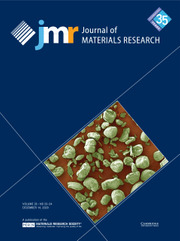Article contents
Polarity of GaN with polar {0001} and semipolar  ${\left\{ {{\bf10} {\bar {\bf 1}\bf1} \right\}}}$ ,
${\left\{ {{\bf10} {\bar {\bf 1}\bf1} \right\}}}$ ,  ${\left\{ {{\bf20}\bar {\bf 2}\bf1} \right\}}}$ ,
${\left\{ {{\bf20}\bar {\bf 2}\bf1} \right\}}}$ ,  ${\left\{ {{\bf11}\bar {\bf 2}\bf2} \right\}}}$ orientations by x-ray photoelectron diffraction
${\left\{ {{\bf11}\bar {\bf 2}\bf2} \right\}}}$ orientations by x-ray photoelectron diffraction
Published online by Cambridge University Press: 05 June 2015
Abstract

A fast and nondestructive method for polarity determination of wurtzite GaN crystals based on x-ray photoelectron diffraction (XPD) has been demonstrated. Photoelectron emission from N 1s core level excited by Mg Kα source was found sufficient for the polarity determination of GaN crystals. XPD polar plots from polar GaN {0001} and semipolar GaN  $\{ 10\bar 11\}$ ,
$\{ 10\bar 11\}$ ,  $\left\{ {20\bar 21} \right\}$ ,
$\left\{ {20\bar 21} \right\}$ ,  $\left\{ {11\bar 22} \right\}$ crystals have been analyzed. Due to dominant electron forward scattering along N–Ga directions, photoelectron intensities either increase or decrease within a relatively narrow emission polar angle range. The slopes of polar plots are found noticeably different in the polar angle range of 20°–25° for (0001) or
$\left\{ {11\bar 22} \right\}$ crystals have been analyzed. Due to dominant electron forward scattering along N–Ga directions, photoelectron intensities either increase or decrease within a relatively narrow emission polar angle range. The slopes of polar plots are found noticeably different in the polar angle range of 20°–25° for (0001) or  $\left( {000\bar 1} \right)$ crystals, respectively. The semipolar GaN substrates can be divided into two groups, depending on whether m-plane or a-plane is perpendicular to the semipolar surface. It was found that the slopes of the polar plots are different in the angular range of 20°–27° for semipolar GaN
$\left( {000\bar 1} \right)$ crystals, respectively. The semipolar GaN substrates can be divided into two groups, depending on whether m-plane or a-plane is perpendicular to the semipolar surface. It was found that the slopes of the polar plots are different in the angular range of 20°–27° for semipolar GaN  $\left\{ {10\bar 11} \right\}$ , 10°–22° for GaN
$\left\{ {10\bar 11} \right\}$ , 10°–22° for GaN  $\left\{ {20\bar 21} \right\}$ substrates, while for the GaN
$\left\{ {20\bar 21} \right\}$ substrates, while for the GaN  $\left\{ {11\bar 22} \right\}$ semipolar planes, the slopes are different in the range of 0°–15° with respect to the surface normal.
$\left\{ {11\bar 22} \right\}$ semipolar planes, the slopes are different in the range of 0°–15° with respect to the surface normal.
Information
- Type
- Articles
- Information
- Journal of Materials Research , Volume 30 , Issue 19: Focus Issue: Nitrides and Oxynitride Materials , 14 October 2015 , pp. 2881 - 2892
- Copyright
- Copyright © Materials Research Society 2015
References
REFERENCES
- 8
- Cited by

